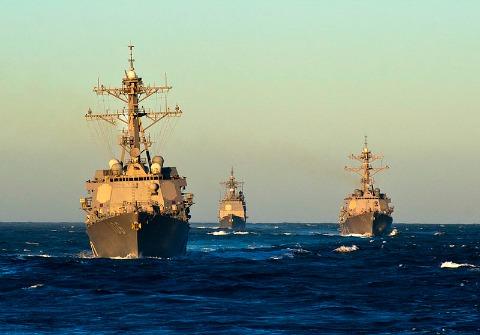
When it comes to energy use, the military is a bona fide blur of consumption. The U.S. military—'Merica!—is one of the biggest users of energy in the world, and far and away the largest consumer among American governmental agencies. Jets are the worst culprit, madly gulping around 70% of all the military-used fuel, but fret not, the navy’s fleet does an impressive amount of fuel quaffing of its own. (For example, a U.S. Navy destroyer can burn 1,000 gallons of gas per hour.)
In addition to requiring so much fossil fuel, the refueling process for Naval ships can also be mighty challenging in rough sea conditions, as the tanker boats have to properly align with the massive—and lurching—ships.
Between the fuel-gorging and the daunting to-and-fro exchange, you can understand the explains the recent hoopla over naval researchers’ recent breakthroughs in working toward a cheap, convenient and plentiful fuel source: seawater!
In case you didn't know, ocean water makes up more than 70% of the Earth’s surface. And look at it. Just sloshing around over there, mocking our inability to fully exploit it for our consumption addiction! That’s why scientists decided it was time to get tough with the tides. For nearly a decade they have been laboring to transform the carbon dioxide and hydrogen from the salty seas into a liquid hydrocarbon fuel. And in a recent proof-of-concept test, the researchers successfully flew a model airplane using this seawater fuel, making the old-time "airship" name all the more apt!
This development could be the game changer we've been on the prowl for. Navy ships could remain operational at all times if they were able to create their own fuel, ditching the need for the frequent fuel-ups currently required (which, sadly for all the sailors and buxom dock maidens, probably means fewer land visits). And the discovery has broader, bolder commercial potential: researchers predict the fuel would cost about $3-6 dollars per gallon, and could be widely available within a decade.
The feasibility for using sea fuel for everyday purposes is still unclear, so don’t get your breath up for gas o’ the sea in your car anytime soon. Still, it’s a promising development to help wean us off fossil fuels and head towards cleaner energy. Indeed, while there are plenty of reasonable critiques of our massive military-industrial complex, the Department of Defense is taking energy use and climate change seriously, and its massive funding allows the military to be on the forefront of certain good-stewardship innovations. And yes. There’s probably some irony there if you look for it.
Image: commons.wikimedia.org.






